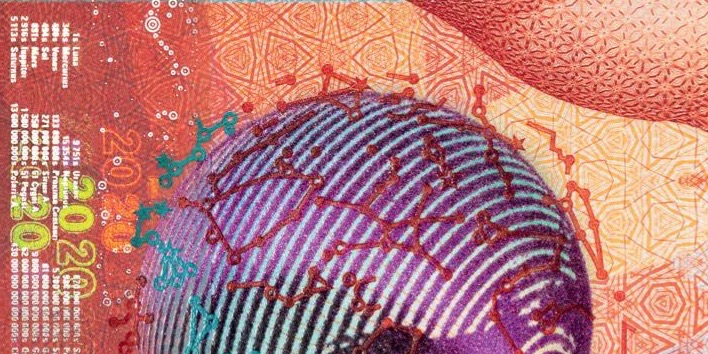Astronomy in your wallet


The Swiss 20 franc note. (Image SNF)
There is a good chance that you are carrying 51 Pegasi around with you. The name of the star, around which the Geneva astronomers Michel Mayor and Didier Queloz discovered a planet in 1995, is on the new Swiss 20 franc banknote. In addition, there is a ten-digit number – an example of Swiss banking secrecy.
Upon first glance at the 20 franc note, one notices the hand holding a prism through which light is dispersed into various colours – “into a spectrum”, remarks David Ehrenreich, Professor at the University of Geneva and a member of the NCCR PlanetS. Spectroscopy is one of the most important tools in astrophysics. David Ehrenreich uses spectroscopy to investigate the chemical composition of the atmospheres of distant exoplanets. He is pleased with the astronomical motifs on the new 20 franc note, including a globe with a starry sky and the star 51 Pegasi, around which Michel Mayor and Didier Queloz discovered a planet orbiting a sun-like star outside our solar system for the first time. “It seems that this banknote is telling the Swiss exoplanet success story,” says David Ehrenreich.
How did the stars make it onto the banknote issued by the Swiss National Bank in May 2017? “Light is the central motif of the 20 franc note,” says Manuela Pfrunder, who was commissioned to design the new banknote series. “Above the globe, which recurs as a security feature on every note, are images of stars which combine culture and light in a very attractive way.” Light is reflected not only in the prism, but also in the map displayed on the note’s security strip. Here it was important to find a representation that extends beyond the borders of Switzerland and thus represents an overarching motif of light, as the graphic artist explains. After extensive research, the choice was made for a map of Switzerland that shows night-time light emissions in the form of flashing circles. If you slowly tilt the banknote backwards, light pollution within Switzerland appears in a rainbow of colours.
Swiss discoverer of an exoplanet and dark matter
In addition to radiated light, incoming light is also displayed on the new note – a list indicating how long light from different celestial bodies has to travel before it reaches Earth. Among the 21 objects are the Moon, the planets of our solar system, the nearest star Proxima Centauri, the centre of the Milky Way- Sagittarius A*, the cosmic microwave background CMB, but also 51 Pegasi and another object related to Switzerland- the coma cluster listed as “Galaxiae Comae Berenicis”. In 1933 Fritz Zwicky, a Swiss Astronomer who emigrated to the US, concluded that visible matter in this cluster of galaxies was far from sufficient to hold the cluster together and coined the term “Dark Matter”.
Who made the interesting selection of objects and on the basis of which criteria? This is an example of genuine Swiss banking secrecy. The Swiss National Bank writes, “The experts have signed a confidentiality agreement obliging them not to disclose their involvement in the technical expertise for the ninth banknote series.” The question of who came up with the original idea of stating the distances between various celestial bodies and the earth in light seconds remains unanswered. For example, the number next to 51 Pegasi is “1 580 000 000s”. But the values caused confusion, as astute observers found that the distance to Mercury is shorter than the distance to Venus.
In the magazine ORION published by the Swiss Astronomical Society SAG, Beat Bühlmann solved the mystery. “The distances from the earth to the planets are constantly changing. Thus it can be assumed that the entire list of numbers refers to a very special date,” writes the author of SAG. Together with fellow club member Roland Stalder and SAG president Christian Wernli, he set to work to find the date. Based on the given distance between the Earth and the Sun, and using an astronomy computer programme they narrowed the timeframe down to two possible dates; 8 November and 24 February. With the help of the SkySafari App and the distances between Mercury and Venus indicated on the new banknote, they then came up with the date and time of 23 February 1987 at 8:52 CET. This result was confirmed by the Swiss National Bank. “But what happened that day?” asked the author in ORION. “Right! The neutrinos of the Supernova 1987A reached Earth after a journey of approximately 168,000 years.” (bva)
Categories: External Newsletter, News
